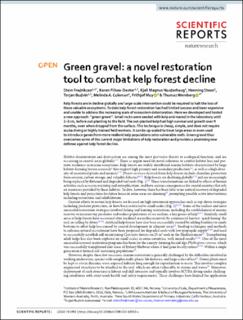Green gravel: a novel restoration tool to combat kelp forests decline.
| dc.contributor.author | Fredriksen, Stein | |
| dc.contributor.author | Filbee-Dekster, Karen | |
| dc.contributor.author | Norderhaug, K.M. | |
| dc.contributor.author | Steen, Henning | |
| dc.contributor.author | Bodvin, Torjan | |
| dc.contributor.author | Coleman, M.A | |
| dc.contributor.author | Moy, Fritjjof | |
| dc.contributor.author | Wernberg, Thomas | |
| dc.date.accessioned | 2020-11-18T10:43:24Z | |
| dc.date.available | 2020-11-18T10:43:24Z | |
| dc.date.created | 2020-11-10T15:56:20Z | |
| dc.date.issued | 2020 | |
| dc.identifier.issn | 2045-2322 | |
| dc.identifier.uri | https://hdl.handle.net/11250/2688434 | |
| dc.description.abstract | Kelp forests are in decline globally and large-scale intervention could be required to halt the loss of these valuable ecosystems. To date kelp forest restoration has had limited success and been expensive and unable to address the increasing scale of ecosystem deterioration. Here we developed and tested a new approach: “green gravel”. Small rocks were seeded with kelp and reared in the laboratory until 2–3 cm, before out-planting to the field. The out-planted kelp had high survival and growth over 9 months, even when dropped from the surface. This technique is cheap, simple, and does not require scuba diving or highly trained field workers. It can be up-scaled to treat large areas or even used to introduce genes from more resilient kelp populations onto vulnerable reefs. Green gravel thus overcomes some of the current major limitations of kelp restoration and provides a promising new defense against kelp forest decline. | en_US |
| dc.language.iso | eng | en_US |
| dc.title | Green gravel: a novel restoration tool to combat kelp forests decline. | en_US |
| dc.type | Peer reviewed | en_US |
| dc.type | Journal article | en_US |
| dc.description.version | publishedVersion | en_US |
| dc.source.journal | Scientific Reports | en_US |
| dc.identifier.doi | 10.1038/s41598-020-60553-x | |
| dc.identifier.cristin | 1846656 | |
| cristin.ispublished | true | |
| cristin.fulltext | original | |
| cristin.qualitycode | 1 |
Tilhørende fil(er)
Denne innførselen finnes i følgende samling(er)
-
Articles [3009]
-
Publikasjoner fra CRIStin [3056]
